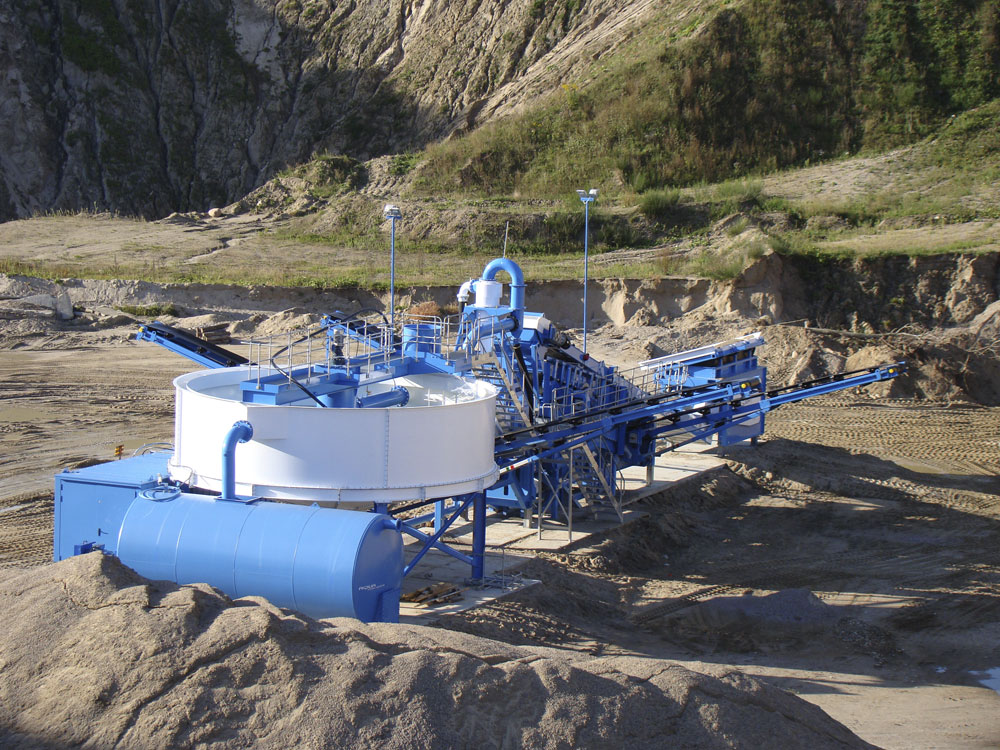Water Watch

Water recycling tops the agenda for washing plant operators
The inclusion of recycling equipment on washing plant installations has risen significantly in recent years, as quarry operators realize that in addition to the altruistic benefit of protecting one of the world’s most precious natural resources, there are greater efficiency gains to be achieved.
The specification of equipment, such as thickeners and filter presses, has seemingly progressed from being seen as something that was done only at the behest of planning authorities. As awareness has grown of the real potential for water recycling technologies to improve the efficiency of traditional quarrying and C&D waste recycling processes, their use in existing operations and new installations has increased significantly.
Peter Craven, marketing manager at CDE Global, explained: ‘As recently as three or four years ago, a thickener or filter press was only specified on around 20% of our washing plant installations. The last 12 months has seen this figure rise to around 80%.’
According to CDE, this increase has not been restricted to any specific geographical area with recent installations in Ireland, the UK, Europe, Middle East, Australia, South America and South Africa being reported.
The key drivers behind the increased specification of this equipment differ from one installation to the next and include issues concerning the space available on site to accommodate large settling ponds, the availability of the volumes of water required to operate a new washing plant, reducing health and safety risks on site and the efficiency improvements offered through significantly reduced operational costs.
‘We have focused on the potential efficiency gains for a number of years now when in discussion with both new and existing clients’, said Mr Craven. ‘The management of large settling ponds is a very expensive process and one which the introduction of a thickener can significantly reduce. If the full sludge-management system, including a filter press is specified, these settling ponds can be removed completely from site.’
In the UK market, the specification of water-recycling equipment has been most prevalent on construction and demolition waste-recycling operations. While it is usually the case that traditional sand and gravel or hard rock quarries are located in rural settings on large sites, the opposite is the case for recycling plants.
‘The nature of the material being processed means these sites are located in urban areas and, as a result, some degree of water recycling is essential on all of our C&D waste-recycling plants,’ explained Mr Craven. ‘We have many plants working on sites located in built-up industrial and residential areas where not only is there not the space to contemplate settling ponds, but the health and safety issues surrounding these ponds rule them out of consideration at the very outset.’
The current demand for water-recycling equipment is also coming from outside the recycling sector. ‘First time operators considering a washing plant on a site that has previously operated a dry crushing and screening process are more focused on the volume of water required to run the plant than those already operating washing plants,’ added Mr Craven.
‘The issue of the space required for ponds is more acute for those not already operating these ponds and one of the first issues they are concerned with is reducing the space requirement. The specification of a thickener and filter press is the obvious way to achieve this.’
It is not exclusively the ponds issue that leads operators to specify some sort of water-recycling system. An equally pressing issue is gaining access to the volumes of fresh water required to run the washing plant should a thickener not be included. On a recently completed CDE project in Poland this was precisely the issue that the customer was faced with.
‘Our customer was operating an EvoWash sand washing plant after their dry screening process but had a requirement to increase sand production following the award of a new contract,’ said Mr Craven. ‘The customer chose our M2500 mobile washing plant to deliver this increased capacity but they simply did not have access to the volumes of water required to run the new plant.’
The introduction of an AquaCycle thickener on this upgraded washing plant ensured that the customer took advantage of the increased sand and aggregate production capacity while requiring less water to do so. The introduction of the thickener alone has allowed the operator to recycle between 85% and 90% of the water used to feed the washing plant.
It is rarely the case that operators will only have one of these issues to deal with and, according to CDE, it is usually a combination of factors working together that lead to the conclusion that a thickener and/or filter press is needed.
‘On a recent project in South Africa the customer had a number of concerns,’ explained Mr Craven. ‘First, they were spending considerable time and money cleaning out their existing ponds and reprocessing material due to the inefficiency of its existing sand washing plant so the first priority for them was more efficient sand washing. They were also adamant that they wanted to address their ponds issue and reduce not only the space they were occupying, but the cost of managing them.’
While thickeners are generally used in the mining sector in South Africa, CDE say this is the first time a thickener system has been installed on a traditional quarrying operation in the country. A further consideration for the customer was the location of the washing plant adjacent to a local river. With this at the forefront of the customer’s mind, the safe storage of waste material from the washing plant was of paramount importance.
‘We fully expect this trend towards thickeners and filter presses to continue,’ said Mr Craven. ‘We have recently seen the installation of our first water-recycling systems in six new countries and the expectation is that this will lead to more in the coming months and years.’
For more information visit: www.cdeglobal.com


